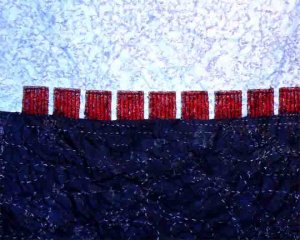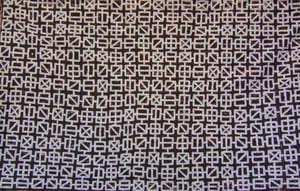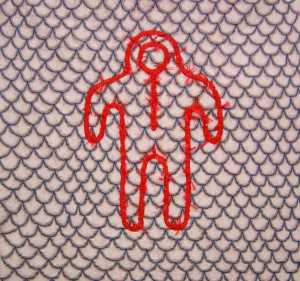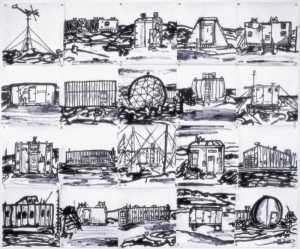|
Self-contained cartography
animation: Lisa Roberts
Sydney 2007
artwork: Stephen Eastaugh
Argentina 2007
sound: Jon Hizzard
Flinders Island 2003

Title: SELF-CONTAINERS. (Antarctica)
Year: 2007
Medium: Acrylic, thread, linen
I have lived in many cargo containers
or dongas as they are called
in some parts of the world
like Antarctica and Australia.
This painting is a line of cargo containers
at McMurdo station Ross Island Antarctica.
McMurdo is the primary American station
and the largest human village in Antarctica.
Roughly 1200 people stay there each summer season.
A lot of stuff is needed to look after that many folks.
A lot of stuff is also moved back to the States.
Rubbish is removed from Antarctica
and supplies brought in each year
in hundreds of containers.
Contained and moved.
I am to a degree self–contained
and always moving from place to place
so I have a rather silly relationship
with these large metal boxes.
They are compact units that move a lot.
Packed, secured, sealed, shipped, opened.
Positioned someplace for a season
then moved again and again.
Finally some containers are utilized
as permanent dwellings.
What do I contain,
when am I full
and where do I finally locate myself
are a few questions I toy with.
Stephen Eastaugh, Argentina 2008-08-29

Title: S.E.W.N. Cardinal points. (Antarctica)
Year: 2006
Medium: Acrylic, thread, linen
I have sewn and painted a pattern
based on the cardinal points of cartography.
Antarctica is a place where mapping is still
a major element of research.
Locating oneself in this white wilderness
is highly important and rather tricky.
I am fond of maps, always have been
and there is indeed a relationship
between art and cartography
as they both attempt to make
meaning of the world
or communicate information.
The similarities between maps and art
revolve around both attempting
to give information.
Turning the unfamiliar into the familiar.
It is presumed
that the first scribblings
in the dirt by humans
were maps.
Unlike cartography
which is concerned with location,
law and information.
I concern myself with dislocation,
experimentation,
imagined space and mystery.
The grid pattern I use
is also influenced by Tongan tapa designs.
I wanted in some way to make
a raw Antarctic art
as someone had to do it!
There has never been any indigenous people on the Ice,
very little art has been made in Antarctica.
This work uses cartography and pattern
to try to locate myself somewhere somehow.
Stephen Eastaugh,
Amsterdam, 06/01/2007 10:20 PM

Title: Immersion Suit and Tie, (Southern Ocean)
Year: 2006
Medium: Mixed media

Title: Casey studies. (Antarctica)
Year: 2000
Medium: Series of ink on tarp
Antarctica is hard to map,
in every sence of the word.
New charts are made to navigate
every voyage south.
And when you arrive
you only know it
in terms of what it is not.
You can be disorientated,
feeling like you're nowhere
in any sense that you've ever known.
Antarctica is contradictory.
It doesn't seem to make sense
that the warming seas look like tipping the balance
to hasten the next ice age.
And yet scientists know this is happening,
from what they read in the ice.
| 